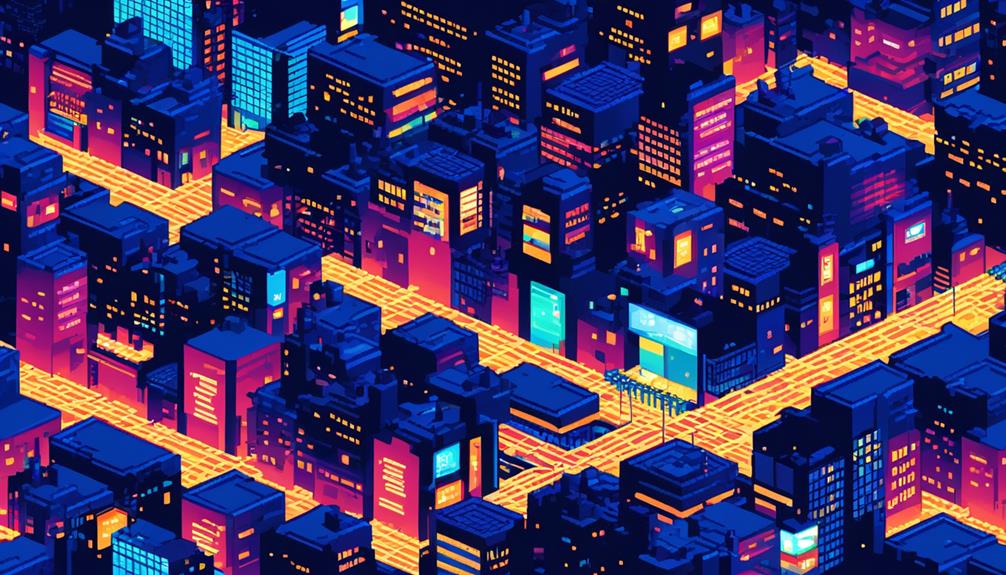In the era of digital transformation, smart cities are emerging as the future of urban development. With the increasing need for connectivity, data analysis, and efficient management of resources, fiber optic infrastructure has become essential for the seamless functioning of smart city applications.
The advantages of fiber optics are numerous and undeniable. From its lightning-fast data transmission capabilities to its ability to handle large bandwidth requirements, fiber optics pave the way for real-time data analysis, improved citizen services, and enhanced sustainability.
However, the implementation of fiber optic infrastructure is not without its challenges. As we delve into the intricacies of fiber optic networks in smart cities, we will explore the importance, benefits, and future implications of this technology in supporting the growth and development of smart cities.
Key Takeaways
- Fiber optics in smart cities provide lightning-fast internet speeds, reliable connection, and scalability, which are essential for seamless streaming, quick downloads, and smooth gaming experiences.
- Fiber optic networks support smart city applications such as traffic monitoring, video surveillance, and real-time data collection and analysis, enhancing public safety and optimizing traffic flow.
- The benefits of fiber optic networks in smart city development include enhanced connectivity for residents and businesses, improved efficiency through real-time data analysis, and longer lifespan compared to traditional copper networks.
- Collaboration between service providers, government entities, and private organizations is crucial for successful deployment of fiber optic infrastructure, overcoming implementation costs, and laying the foundation for continued development and growth of smart cities.
Importance of Fiber Optics in Smart Cities

Fiber optics play a crucial role in the development and functioning of smart cities. They provide lightning-fast internet speeds, reliable connectivity, and enhanced security. In today's urban landscape, smart cities heavily rely on fiber optic networks to support various public infrastructure and services. One of the key advantages of fiber optics is their ability to deliver lightning-fast internet speeds. This enables seamless streaming, quick downloads, and smooth gaming experiences for residents and businesses. High-speed connectivity is essential for supporting data, voice, and video entertainment, as well as high-speed internet and CATV services in smart cities.
Moreover, the reliable and consistent connection offered by fiber optics is vital for ensuring uninterrupted access to internet services in smart cities. This reliability is crucial for supporting various smart city technologies, such as traffic management systems, public safety networks, and energy-efficient infrastructure. Fiber optics also have scalability and future-proofing capabilities, allowing cities to adapt to evolving technology needs without significant infrastructure upgrades. This flexibility ensures that smart cities can keep up with the increasing demands for bandwidth and connectivity.
In addition to their speed and reliability, fiber optics also enhance security in smart cities. The minimal risk of unauthorized access and interception makes fiber optic networks a secure choice for transmitting sensitive data and maintaining the integrity of smart city operations. By investing in fiber optic infrastructure, cities can unlock the full potential of their smart city initiatives. This promotes economic growth, sustainability, and improved quality of life for their residents.
Challenges in Implementing Fiber Optic Infrastructure
Securing funding and overcoming costs are primary challenges encountered in the implementation of fiber optic infrastructure. The deployment of fiber optic networks is a crucial aspect of building smart cities, as it forms the backbone of various smart city technologies, enabling efficient data transmission and connectivity. However, the high costs associated with laying fiber optic cables and establishing network infrastructure pose significant obstacles.
To provide a clear overview of the challenges faced in implementing fiber optic infrastructure, the following table highlights the key hurdles and corresponding solutions:
| Challenges | Solutions |
|---|---|
| Securing funding | Collaborative efforts between public and private stakeholders can help secure necessary funding for fiber optic projects. Municipal bonds or public-private partnerships can be explored to cover the costs. |
| Regulatory restrictions | Advocating for regulatory reforms and streamlining bureaucratic procedures can facilitate the expansion of fiber networks. Engaging with regulatory authorities and seeking their support is crucial in overcoming this challenge. |
| Complexities in deployment | Adapting existing infrastructure and addressing complexities in densely populated areas require careful planning and specialized installation techniques. Collaboration with utility companies and infrastructure owners can help minimize disruptions and optimize fiber deployment. |
Overcoming these challenges is essential for the successful implementation of fiber optic infrastructure in smart cities. By establishing robust fiber networks, cities can support the growing demand for data and connectivity, enabling the Internet of Things (IoT) devices to function seamlessly. Moreover, fiber optics play a vital role in improving various aspects of public infrastructure, such as traffic management, enhancing the overall quality of life for citizens.
Benefits of Fiber Optic Networks in Smart City Development

What are the advantages of implementing fiber optic networks in smart city development?
Fiber optics provide fast and reliable internet speeds, making them an essential component for smart cities. Here are three key benefits of deploying fiber optic networks:
- Enhanced Connectivity: Smart cities leverage the high speeds of fiber optic networks to ensure seamless connectivity for residents and businesses. With fiber networks, users can access the internet at lightning-fast speeds, enabling them to stream high-definition videos, participate in video conferences, and download and upload large files without any lag or buffering. According to the Fiber Broadband Association, fiber optic networks can provide speeds of up to 100 gigabits per second, significantly surpassing the capabilities of traditional copper-based networks.
- Improved Efficiency and Productivity: The deployment of fiber optic networks plays a crucial role in promoting efficiency and productivity in smart cities. With reliable and consistent internet connectivity, smart city applications and services can operate seamlessly, enabling real-time data collection and analysis. This allows for better resource management, traffic optimization, and improved delivery of essential services such as healthcare and education. Fast and reliable internet connections also support businesses in smart cities, facilitating smooth communication, online transactions, and remote working opportunities.
- Future-Proofing and Scalability: Fiber optic networks are highly scalable and future-proof, offering long-term benefits for smart city development. As technology continues to evolve, fiber networks can accommodate increasing bandwidth demands and support the deployment of new applications and services. This adaptability ensures that smart cities can keep pace with advancements in technology, supporting sustainable growth and development. Furthermore, fiber optic networks have a longer lifespan compared to traditional copper networks, reducing the need for frequent infrastructure upgrades and maintenance.
Future Growth and Expansion of Fiber Optic Infrastructure
The expansion and future growth of smart cities heavily rely on the continued development and implementation of robust fiber optic infrastructure. Fiber optic networks are essential for supporting the increasing demand for high bandwidth and reliable internet connectivity in urban areas. As smart cities continue to evolve and integrate advanced technologies, the need for efficient data transmission becomes paramount.
Fiber optic infrastructure provides the foundation for the seamless flow of data across various smart city applications and services. The scalability and future-proofing capabilities of fiber networks make them adaptable to the evolving technology needs of smart cities. With the ability to support high-speed internet, CATV services, wireless connectivity, and the integration of smart city technologies, fiber optic networks form the backbone of urban infrastructure. They enhance the overall performance and efficiency of smart city systems, enabling real-time monitoring, data analytics, and effective decision-making.
Moreover, fiber optic networks enhance security in smart cities by minimizing the risk of unauthorized access. The data transmitted through fiber cables is more secure compared to traditional copper wires, reducing the vulnerability to cyber threats. This secure and reliable infrastructure is crucial for the efficient operation of smart city applications such as intelligent transportation systems, smart grids, and public safety systems.
However, the deployment of fiber optic infrastructure in smart cities poses certain challenges. The collaboration between service providers, government entities, and private organizations is crucial for overcoming obstacles such as high implementation costs and the need for extensive planning and coordination. By working together, stakeholders can ensure the successful expansion and future growth of fiber optic infrastructure, laying the foundation for the continued development of smart cities.
The Role of Fiber Optics in Supporting Smart City Technologies

Fiber optics play a pivotal role in enabling high-speed, reliable, and secure communication infrastructure essential for the successful implementation of smart city technologies. Here are three key ways in which fiber optics support the development and operation of smart cities:
- Supporting Public Infrastructure:
Fiber optics are vital for supporting various smart city applications, such as traffic monitoring and management. By connecting traffic lights and other sensors to a fiber optic network, real-time data on traffic conditions can be collected and analyzed. This data can then be used to optimize traffic flow, reduce congestion, and enhance road safety. Furthermore, fiber optics enable the transmission of large amounts of data required for video surveillance systems, enhancing public safety in urban areas.
- Enabling Seamless Data Transmission:
The ability of fiber optics to handle large amounts of data at incredibly fast speeds is crucial for the seamless operation of smart city services. With the increasing deployment of smart devices and the Internet of Things (IoT), fiber optics provide the necessary bandwidth to transmit data between various devices, enabling efficient communication and data analysis. This seamless data transmission is particularly important for emerging technologies like autonomous vehicles, which rely on real-time data to navigate urban environments safely.
- Promoting Economic Growth and Sustainability:
Fiber optics support the integration of emerging technologies and foster economic growth in smart cities. With their lightning-fast speeds and reliability, fiber optics facilitate the implementation of smart grid systems, remote healthcare services, disaster management, and other innovative applications. By enabling real-time data analysis, fiber optics contribute to the efficient use of resources, reducing energy consumption, and promoting sustainable development.
Frequently Asked Questions
What Infrastructure Is Needed for Smart City?
To build a smart city, a robust and advanced infrastructure is required. This includes a comprehensive wireless connectivity network that enables seamless communication between devices and systems.
Additionally, the Internet of Things (IoT), edge computing, and big data analytics are essential components for processing and analyzing vast amounts of data generated by sensor networks.
Smart cities also require infrastructure for intelligent transportation systems, public safety systems, environmental monitoring, and a smart grid.
Cloud computing plays a crucial role in storing and processing this data efficiently.
What Is Primarily Used for Connectivity in Smart Cities?
Wireless technologies, including cellular networks, satellite communication, mesh networks, Wi-Fi connectivity, LoRaWAN technology, 5G networks, Narrowband IoT, and Bluetooth connectivity, are primarily used for connectivity in smart cities. These technologies enable the Internet of Things (IoT) ecosystem, supporting various applications and services in smart city infrastructure.
Fiber optic infrastructure serves as the backbone for these wireless technologies, providing high-speed internet connectivity, reliable data transmission, and seamless operation of smart city applications. It is a crucial component for enabling efficient and effective connectivity in smart cities.
What Kind of Networks Can Be Used in Smart City?
Smart cities require various types of networks to enable connectivity and support the Internet of Things (IoT) ecosystem.
These networks include wireless solutions like 5G networks, cellular technologies, and satellite communication.
Additionally, mesh networks, Wi-Fi connectivity, LoRaWAN technology, Narrowband IoT (NB IoT), and Power Line Communication (PLC) are used for different applications in smart cities.
These diverse network options ensure seamless connectivity, efficient data transmission, and enable the integration of smart devices and systems for the advancement of smart city initiatives.
What Is Fiber Optic Infrastructure?
Fiber optic infrastructure is a network of thin glass or plastic fibers that transmit data using light, offering numerous benefits such as high bandwidth capacity, reliability, and resistance to interference.
Unlike traditional copper cables, fiber optics provide faster data transmission speeds and are more durable.
The installation process involves laying fiber optic cables, while maintenance and troubleshooting require specialized equipment.
Advancements in fiber optic technology are continuously improving connectivity, data protection, and cost considerations for implementation.
The future of fiber optic infrastructure holds promise for rural areas, smart cities, and various industries.
